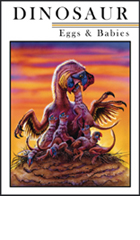
Dinosaur: Eggs & Babies 2003
Distributed by Janson Media, 88 Semmons Road, Harrington Park, NJ 07640; 201-784-8488
Produced by Centre Communications
Director n/a
DVD, color, 57 min.
Jr. High - Adult
Biology, Paleontology
Date Entered: 07/28/2004
Reviewed by Gloria Maxwell, Reference Librarian, Penn Valley Community College, Kansas City, MOPeople have been fascinated by dinosaurs ever since they were discovered. Over the last one hundred and fifty years, paleontologists were focused on finding the most fossils, the biggest specimens, or new dinosaur species. Leading expert, Dr. Robert Bakker, groups dinosaurs into three categories: 1) gigantic, long neck, small head plant eaters; 2) big, beaked, duckbilled plant eaters, and 3) big-brained, meat eaters, large and small. The last twenty-five years have focused on how dinosaurs lived and their life cycles.
The American West was the site of early dinosaur discoveries, and the techniques that were developed there are still used today. In the 1920s, Roy Chapman Andrews discovered dinosaur eggs in the Gobi Desert in China and Mongolia, but impending war intervened and stopped expeditions to this region until more recent times. Dinosaur eggs had been discovered in Britain and France much earlier, but they were dismissed as bird eggs. It was only after more than a year of work and repeated discoveries by Andrews that they were finally accepted as dinosaur eggs.
This documentary is divided into several sections that attempt to answer questions related to defining dinosaurs, explaining egg laying patterns, and whether or not dinosaur parents nurtured their young. Amazingly, recent discoveries played into these areas and provide clues to answer these questions. Among the most important recent discoveries are those related to dinosaur eggs and nests. Fossilized dinosaur egg shells show amazing similarity to modern bird eggs in that they both have pores. There are two types of dinosaur eggs: spherical and elongated. Raptors and predator dinosaur species have elongated eggs, while the spherical eggs are associated with sauropods and duck-beaked species. There is a difference in texture between these two types of eggs.
In the Morrison Formation (a remote area of the Four Corners in the American southwest) eggs and baby dinosaurs have been found together. Their sizes vary from embryos to hatchlings. This discovery raised questions about how and why they died and why the hatchlings didn’t leave the nest. Dinosaur nests show that eggs were laid in groups, in patterns, and in certain directions, indicating nesting behavior.
Additional significant discoveries in the Badlands in the 1970s include dinosaur embryos found still in the eggs. In Patagonia, baby dinosaur skin was found which provided proof that their skin was scaly and had different patterns. Another important category of dinosaur discovery is called “Life Assemblages,” which refers to finding two battling dinosaurs buried together, or a flock of dinosaurs buried alive together (usually due to flash flooding or other natural catastrophes). This type of discovery is especially important to scientists and paleontologists trying to unlock the secrets of dinosaur life, social behavior patterns and how they reared their young.
This program ends with some of the conclusions that have been developed based on these recent discoveries. Oviraptors brooded their eggs like cranes do today, which confirms they were warm-blooded. A flock of Protoceratops lived together much like a colony of prairie dogs. From life assemblages, scientists have learned more than was known from 150 years of dinosaur discoveries.
The final question asks if dinosaurs evolved into birds. Dr. Phillip Currie states that dinosaur eggs are more like bird eggs than reptile eggs. More and more scientists say that birds are living dinosaurs.
The video quality of Dinosaur: Eggs and Babies is excellent, with stunning computer generated visual images of dinosaurs highlighting the program, and backed by a good music soundtrack.
This educational program is suitable for classroom use as well as family viewing for anyone interested in dinosaurs. This should be particularly appealing for younger children who are fascinated by dinosaurs (isn’t that all children?).
Extremely Highly Recommended.